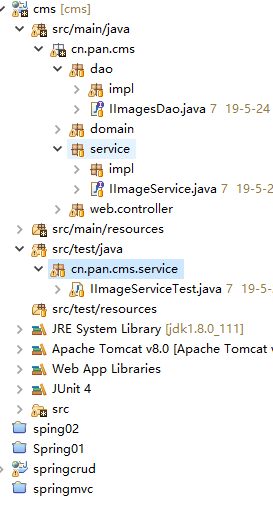1:CMS-内容管理系统
1.新闻发布系统
2.博客blog管理系统
3.员工管理系统
4.图书管理系统
5.qq空间…等等
特点: 发布信息
2:Maven:结构
它可以帮我们自动导包,自动编译,规范代码等
老師还没教,今天只学了一个机构
------四大主要结构
src/main/java -> Java代码的存放位置
src/main/resources -> 资源文件的存放位置
src/test/java -> 测试代码的位置
src/test/resources -> 代码资源文件的位置
3:项目搭建的常规操作/xml配置
1.建表:
数据库创建对应的表
2.键domain,dao,service,controller
domain: 域对象 ,对应数据库中的元素
dao: 操作数据库,增删改查
service: 业务层调用dao层,做逻辑判断
controller: 前端控制页面,

3,配置 web.xml,applicationContext.xml,applicationContext-mvc.xml
3.1web.xml配置
<!--0 监听器 -->
<listener>
<listener-class>org.springframework.web.context.ContextLoaderListener </listener-class>
</listener>
<context-param>
<param-name>contextConfigLocation</param-name>
<param-value>classpath:applicationContext.xml</param-value>
</context-param>
<!--1,核心控制器 -->
<servlet>
<servlet-name>dispatcherServlet</servlet-name>
<servlet-class>org.springframework.web.servlet.DispatcherServlet</servlet-class>
<!--2,Spring核心文件路径 -->
<init-param>
<param-name>contextConfigLocation</param-name>
<param-value>classpath:applicationContext-mvc.xml</param-value>
</init-param>
<!--3 跟随启动创建 -->
<load-on-startup>1</load-on-startup>
</servlet>
<!--4,过滤器 -->
<servlet-mapping>
<servlet-name>dispatcherServlet</servlet-name>
<url-pattern>/</url-pattern>
</servlet-mapping>
<!--5,请求乱码! -->
<filter>
<filter-name>CharacterEncodingFilter</filter-name>
<filter-class>org.springframework.web.filter.CharacterEncodingFilter</filter-class>
<init-param>
<param-name>encoding</param-name>
<param-value>utf-8</param-value>
</init-param>
</filter>
<filter-mapping>
<filter-name>CharacterEncodingFilter</filter-name>
<url-pattern>/*</url-pattern>
</filter-mapping>
3.2applicationContext.xml配置
<?xml version="1.0" encoding="UTF-8"?>
<beans xmlns="http://www.springframework.org/schema/beans"
xmlns:xsi="http://www.w3.org/2001/XMLSchema-instance"
xmlns:context="http://www.springframework.org/schema/context"
xmlns:mvc="http://www.springframework.org/schema/mvc"
xsi:schemaLocation="
http://www.springframework.org/schema/beans
http://www.springframework.org/schema/beans/spring-beans.xsd
http://www.springframework.org/schema/context
http://www.springframework.org/schema/context/spring-context.xsd
http://www.springframework.org/schema/mvc
http://www.springframework.org/schema/mvc/spring-mvc.xsd
" >
<!--1 扫描包 -->
<context:component-scan base-package="cn.pan.cms"></context:component-scan>
<!--2 读取配置文件 -->
<context:property-placeholder location="classpath:jdbc.properties"/>
<!--3,加载DataSource对象,配置4金刚 -->
<bean id="dataSource" class="org.apache.commons.dbcp.BasicDataSource" destroy-method="close">
<property name="driverClassName" value="${jdbc.driverClassName}" />
<property name="url" value="${jdbc.url}" />
<property name="username" value="${jdbc.username}" />
<property name="password" value="${jdbc.password}" />
</bean>
<!--4,配置JdbcTemplate操作数据库 -->
<bean id="jdbcTemplate" class="org.springframework.jdbc.core.JdbcTemplate">
<property name="dataSource" ref="dataSource" />
</bean>
</beans>
3.3applicationContext-mvc.xml配置
<?xml version="1.0" encoding="UTF-8"?>
<beans xmlns="http://www.springframework.org/schema/beans"
xmlns:xsi="http://www.w3.org/2001/XMLSchema-instance"
xmlns:context="http://www.springframework.org/schema/context"
xmlns:mvc="http://www.springframework.org/schema/mvc"
xsi:schemaLocation="
http://www.springframework.org/schema/beans
http://www.springframework.org/schema/beans/spring-beans.xsd
http://www.springframework.org/schema/context
http://www.springframework.org/schema/context/spring-context.xsd
http://www.springframework.org/schema/mvc
http://www.springframework.org/schema/mvc/spring-mvc.xsd
" >
<!--SpringMVC 5大组件 -->
<!-- 引入其他Sprng文件
<import resource="classpath:applicationContext.xml"/> -->
<!--1,扫描包 -->
<context:component-scan base-package="cn.pan.cms"></context:component-scan>
<!--2,注解生效 ,支持特有SpingMVC注解-->
<mvc:annotation-driven />
<!--3,支持静态资源 -->
<mvc:default-servlet-handler />
<!--4,视图解析器 -->
<bean class="org.springframework.web.servlet.view.InternalResourceViewResolver">
<!-- prefix:前缀 -->
<property name="prefix" value="/WEB-INF/views/" />
<!-- suffix后缀 -->
<property name="suffix" value=".jsp"></property>
</bean>
<!--5,上传解析器 -->
<bean id="multipartResolver"
class="org.springframework.web.multipart.commons.CommonsMultipartResolver">
<property name="maxUploadSize">
<value>2000000000</value>
</property>
</bean>
</beans>
3.4:JDBC配置:
jdbc.driverClassName=com.mysql.jdbc.Driver
jdbc.url=jdbc:mysql:///cms
jdbc.username=root
jdbc.password=XXXXXXXXXXXXX
4:页面设计
SystemController -> 进入后台的主页面
ImagesController -> 进入轮播图(CRUD)管理页面
注意事项:凡是WEB-INF中的页面都要通过Controller访问
5:前端合作
5.1 前端会把html做好,然后我们把他做的页面搞到我们的项目中来(图片,js,css的引入路径都要进行修改)
5.2 iframe -> 可以把其它的页面直接放入到页面中来
<iframe src="..." />
5.3 注意点:如果咱们配置有上下文路径:所有跳转的路径前:${pageContext.request.contextPath }
6:图片上传
6.1 form中需要配置 method="post" enctype="multipart/form-data"
6.2 后台要根据上传的文件名进行接收
①./ ②.获取路径 ③.保存图片(fileImg.transferTo(file))
④.保存Images对象(绝对路径的地址,名称)
7:整体操作流程
1,.创建数据库表 t_image

2.搭建web项目
創建一個web項目,模拟Maven 创建四大结构
src/main/java -> Java代码的存放位置
src/main/resources -> 资源文件的存放位置
src/test/java -> 测试代码的位置
src/test/resources -> 代码资源文件的位置
3 .创建.dao.domain.service,controller
domain: 域对象 ,对应数据库中的元素
dao: 操作数据库,增删改查
service: 业务层调用dao层,做逻辑判断
controller: 前端控制页面,
4,配置 web.xml,Spring.xml,SpringMVC.xml及JDBC配置文件
1,web-xml配置:
<!--0 监听器 -->
<listener>
<listener-class>org.springframework.web.context.ContextLoaderListener </listener-class>
</listener>
<context-param>
<param-name>contextConfigLocation</param-name>
<param-value>classpath:applicationContext.xml</param-value>
</context-param>
<!--1,核心控制器 -->
<servlet>
<servlet-name>dispatcherServlet</servlet-name>
<servlet-class>org.springframework.web.servlet.DispatcherServlet</servlet-class>
<!--2,Spring核心文件路径 -->
<init-param>
<param-name>contextConfigLocation</param-name>
<param-value>classpath:applicationContext-mvc.xml</param-value>
</init-param>
<!--3 跟随启动创建 -->
<load-on-startup>1</load-on-startup>
</servlet>
<!--4,过滤器 -->
<servlet-mapping>
<servlet-name>dispatcherServlet</servlet-name>
<url-pattern>/</url-pattern>
</servlet-mapping>
<!--5,请求乱码! -->
<filter>
<filter-name>CharacterEncodingFilter</filter-name>
<filter-class>org.springframework.web.filter.CharacterEncodingFilter</filter-class>
<init-param>
<param-name>encoding</param-name>
<param-value>utf-8</param-value>
</init-param>
</filter>
<filter-mapping>
<filter-name>CharacterEncodingFilter</filter-name>
<url-pattern>/*</url-pattern>
</filter-mapping>
2.Spring.xml --applicationContext.xml配置
<?xml version="1.0" encoding="UTF-8"?>
<beans xmlns="http://www.springframework.org/schema/beans"
xmlns:xsi="http://www.w3.org/2001/XMLSchema-instance"
xmlns:context="http://www.springframework.org/schema/context"
xmlns:mvc="http://www.springframework.org/schema/mvc"
xsi:schemaLocation="
http://www.springframework.org/schema/beans
http://www.springframework.org/schema/beans/spring-beans.xsd
http://www.springframework.org/schema/context
http://www.springframework.org/schema/context/spring-context.xsd
http://www.springframework.org/schema/mvc
http://www.springframework.org/schema/mvc/spring-mvc.xsd
" >
<!--1 扫描包 -->
<context:component-scan base-package="cn.pan.cms"></context:component-scan>
<!--2 读取配置文件 -->
<context:property-placeholder location="classpath:jdbc.properties"/>
<!--3,加载DataSource对象,配置4金刚 -->
<bean id="dataSource" class="org.apache.commons.dbcp.BasicDataSource" destroy-method="close">
<property name="driverClassName" value="${jdbc.driverClassName}" />
<property name="url" value="${jdbc.url}" />
<property name="username" value="${jdbc.username}" />
<property name="password" value="${jdbc.password}" />
</bean>
<!--4,配置JdbcTemplate操作数据库 -->
<bean id="jdbcTemplate" class="org.springframework.jdbc.core.JdbcTemplate">
<property name="dataSource" ref="dataSource" />
</bean>
</beans>
3,SpringMVC.xml--applicationContext-mvc.xml配置
<?xml version="1.0" encoding="UTF-8"?>
<beans xmlns="http://www.springframework.org/schema/beans"
xmlns:xsi="http://www.w3.org/2001/XMLSchema-instance"
xmlns:context="http://www.springframework.org/schema/context"
xmlns:mvc="http://www.springframework.org/schema/mvc"
xsi:schemaLocation="
http://www.springframework.org/schema/beans
http://www.springframework.org/schema/beans/spring-beans.xsd
http://www.springframework.org/schema/context
http://www.springframework.org/schema/context/spring-context.xsd
http://www.springframework.org/schema/mvc
http://www.springframework.org/schema/mvc/spring-mvc.xsd
" >
<!--SpringMVC 5大组件 -->
<!-- 引入其他Sprng文件
<import resource="classpath:applicationContext.xml"/> -->
<!--1,扫描包 -->
<context:component-scan base-package="cn.pan.cms"></context:component-scan>
<!--2,注解生效 ,支持特有SpingMVC注解-->
<mvc:annotation-driven />
<!--3,支持静态资源 -->
<mvc:default-servlet-handler />
<!--4,视图解析器 -->
<bean class="org.springframework.web.servlet.view.InternalResourceViewResolver">
<!-- prefix:前缀 -->
<property name="prefix" value="/WEB-INF/views/" />
<!-- suffix后缀 -->
<property name="suffix" value=".jsp"></property>
</bean>
<!--5,上传解析器 -->
<bean id="multipartResolver"
class="org.springframework.web.multipart.commons.CommonsMultipartResolver">
<property name="maxUploadSize">
<value>2000000000</value>
</property>
</bean>
</beans>
4.JDBC配置文件--jdbc.properties
jdbc.driverClassName=com.mysql.jdbc.Driver
jdbc.url=jdbc:mysql:///cms
jdbc.username=root
jdbc.password=36548021
5.dao层数据库操作
JdbcTemplate 是Sping写好的一个类,专门用来操作数据库的
使用方式很简单, 在配置好JdbcTemplate" <Bean>对象后使用 @Autowired注入 就可以使用了
注入示例:
@Autowired
private JdbcTemplate jdbcTemplate;
配置JdbcTemplate示例
<!--2 读取配置文件 -->
<context:property-placeholder location="classpath:jdbc.properties"/>
<!--3,加载DataSource对象,配置4金刚 -->
<bean id="dataSource" class="org.apache.commons.dbcp.BasicDataSource" destroy-method="close">
<property name="driverClassName" value="${jdbc.driverClassName}" />
<property name="url" value="${jdbc.url}" />
<property name="username" value="${jdbc.username}" />
<property name="password" value="${jdbc.password}" />
</bean>
<!--4,配置JdbcTemplate操作数据库 -->
<bean id="jdbcTemplate" class="org.springframework.jdbc.core.JdbcTemplate">
<property name="dataSource" ref="dataSource" />
</bean>
常用方法:
增删改:update 增删改都是同一个方法,返回的是int值
查询单个:queryForObject 该方法返回的是一个对象
查询所有:query 该方法会返回一个集合
增删改:update
1,增加;jdbcTemplate.update("insert into t_image (storepath,storename,intro,isenabled,inputdate) values (?,?,?,?,?)",
images.getStorepath(),images.getStorename(),images.getIntro(),images.getIsenabled(),images.getInputdate()
);
2;修改jdbcTemplate.update("update t_image set storepath=?,storename=?,intro=?,isenabled=?,inputdate=? where imgid=?",
images.getStorepath(),images.getStorename(),images.getIntro(),images.getIsenabled(),images.getInputdate(),images.getImgid()
);
3;删除;jdbcTemplate.update("delete from t_image where imgid=?",id);
查询方法<比较特殊>
查询比较特殊一点,使用的方法分别有俩个:
queryForObject():
query():
里面的参数使用BeanPropertyRowMapper对象进行查询操作,
该方法返回了一个查询对象
return jdbcTemplate.queryForObject("select * from t_image where imgid=?",
new BeanPropertyRowMapper<>(Images.class),id);
该方法返回了一个查询集合
return jdbcTemplate.queryForObject("select * from t_image where imgid=?",
new BeanPropertyRowMapper<>(Images.class),id);
6.service调用dao层做逻辑判断
不想写了,真TM类
9,新知识总结:
1 JdbcTemplate 数据库操作对象,
该对象可以很简单的操作数据库,需要在Spring.xml中和 连接池一起配置
该对象的用法:
1,使用对象
@Autowired
private JdbcTemplate jdbcTemplate;
2,使用它的方法做增刪改查,
增刪改是同一个方法 update
jdbcTemplate.update("insert into t_image (storepath,storename,intro,isenabled,inputdate) values (?,?,?,?,?)",
images.getStorepath(),images.getStorename(),images.getIntro(),images.getIsenabled(),images.getInputdate()
);
jdbcTemplate.update("delete from t_image where imgid=?",id);
第一个参数:sql语句;
第二个参数:执行参数,该参数可以是一个,也可以是N个,可以做到对很多参数赋值
3, 查询方法比较特殊,
使用了俩个方法进行查询
1,查询单个返回的是一个对象
2.查询所有,返回的是一个集合
注意:该方法的参数列表, 使用了一个 BeanPropertyRowMapper 对象 来做处理对象,该对象使用方式 如下:
查询单个:
return jdbcTemplate.queryForObject("select * from t_image where imgid=?",
ew BeanPropertyRowMapper<Images>(Images.class),id);
查询所有:
List<Images> list = jdbcTemplate.query("select * from t_image",
new BeanPropertyRowMapper<Images>(Images.class));





















 161
161











 被折叠的 条评论
为什么被折叠?
被折叠的 条评论
为什么被折叠?








